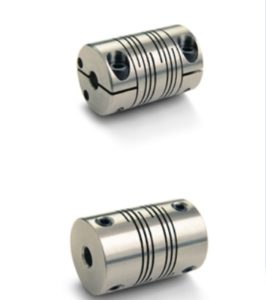Edited by Mike Santora
Design World and Coupling Tips.com caught up with Ruland Manufacturing VP of Sales, Bobby Watkins for a webinar on some of the finer points of coupling installation. Specifically, Watkins touched on bearing support, the causes of misalignment, and common misalignment errors. Below, are some key excerpts from Bobby’s presentation.
Causes of misalignment
 First, you may have parts from different manufacturers with different tolerances. There also may be inaccuracies in systems assembly. Mounts may introduce misalignment into the system as well. Some actuators, which have an integral motor mount on them, are sometimes not as precise as everyone would like. We’ve had cases where the motor mounts themselves, which were supposed to help, but have actually turned into an issue because of the precision of the mount itself.
First, you may have parts from different manufacturers with different tolerances. There also may be inaccuracies in systems assembly. Mounts may introduce misalignment into the system as well. Some actuators, which have an integral motor mount on them, are sometimes not as precise as everyone would like. We’ve had cases where the motor mounts themselves, which were supposed to help, but have actually turned into an issue because of the precision of the mount itself.
The next consideration I want to talk about is system and motor movement during operation. This is a big one. Here are a couple of instances where you’re going to see this. First: shipping a machine. Let’s say a machine was in perfect alignment when it left the factory. It gets shipped to a location… Things move. Floors are uneven, things move around. It happens.
We’ve also seen poor system design. Not only can you have machinery where things have shifted around during shipping, but the base of the machine and the framework of the machine is not robust enough from the get-go. Example: we’ve had some applications where people were having failures on couplings and come to find out precision system couplings can’t stand a lot of misalignment and the framework of the machine was made out of extruded aluminum with very little bracing along the way. You’ve got a system that, under operation, is moving all over the place. That would be a poor system design example. Which brings me to my next point, bearing support.
Bearing Support
Flexible couplings need to be supported on both sides of the coupling, they need bearing support on both sides for flexibles, and the support needs to be close by as well. I talk to customers and say, “Have you got bearings on both sides?” Don’t just go with the answer, “Yes.” Ask the second question, which is, “Okay, fine. You’ve got bearings on both sides. How close are they?” It’s amazing the answers we get sometimes, because everything’s relative with the industry that the machine is in and what people think is close varies greatly.
For example, in a typical motor gearbox application where you’re connecting the two, the bearing is going to be close. The shaft extensions out of motors and gearboxes isn’t tremendous, but occasionally you’ll get an answer:
“Oh, yeah. I got a bearing on both sides.”
How far are they?
“One’s four feet down the line this way and the other one’s six feet down the line the other way…”
That is not close enough to be considered full bearing support because of the run-out at that extended distance from the bearing to the end of the shaft. Again, asking the right questions.
Common selection errors
First is minimum shaft penetration. This is not getting enough engagement of the shaft into the coupling to get an effective clamping action, and this is a problem that pops up from time to time. Also, you might have shaft ends touching. In most cases, you want your shaft ends to be relatively close together but you certainly don’t want them to touch. It causes some very bad things to happen inside that coupling when your shaft ends are touching and there’s misalignment present, as you can imagine. The vibration in the middle is not a good thing, so you don’t want your shaft ends to touch.
Lastly, just a few words on flexible couplings in general: they’re not springs! They’re not meant to be pulled apart, if you will, or axially pulled. Again, that goes back to full bearing support on both sides, and if you have full bearing support on both sides that axial pull isn’t even possible. The flexibles were not designed to take a push-pull action. You can do that with rigids, but you cannot do that with the flexibles.
All good things to keep in mind the next time you are selecting, and subsequently installing, the coupling in your motion system.
Ruland
www.ruland.com
Leave a Reply